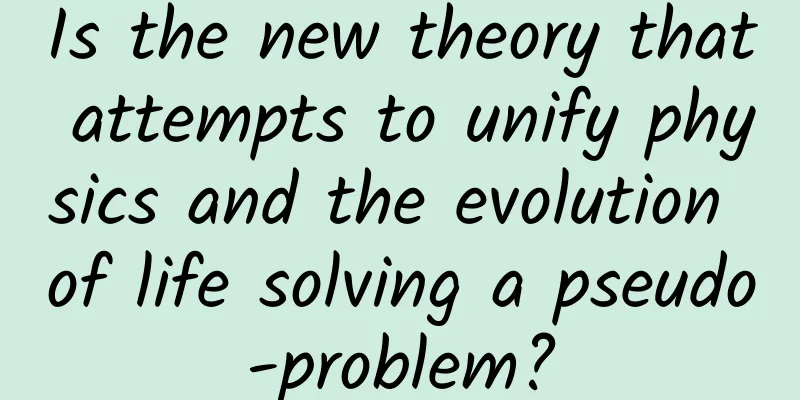Is the new theory that attempts to unify physics and the evolution of life solving a pseudo-problem?

|
Recently, Nature published a paper on "assembly theory". The author hopes to unify physics and biology and try to quantitatively explain the evolution of life in accordance with the laws of physics. This paper has caused a lot of discussion in the academic community, and the famous theoretical physicist George Ellis also published a commentary article in Nature (see "How does purposeless physics give rise to purposeful life?"); but this paper confuses many biologists, who think that the article seems to solve a non-existent problem - is there a need for a new paradigm to unify the evolution of life and physics? Written by Bill Bateman (Associate Professor, Curtin University) Translation | Xiaopo In October 2023, a paper titled “Assembly theory explains and quantifies selection and evolution” [1] appeared in the top scientific journal Nature. The authors of the paper are a team led by Leroy Cronin of the University of Glasgow and Sara Walker of Arizona State University. They claim that their theory is a “connection between physics and biology” that can explain how complex life forms evolved. The paper sparked a strong response. On the one hand, there were media headlines such as "Bold and innovative 'theory of everything' could merge physics and evolution"[2]; on the other hand, there were reactions from scientists. One evolutionary biologist said on a social platform: "After reading it many times, I still have no idea what (this paper) is doing."[3] Another scientist said: "I feel even more confused after reading the paper... I think I forgot my own name after reading that paper."[4] As an evolutionary biologist, I felt compelled to read this paper for myself. Is assembly theory really the radical new paradigm that the authors suggest it is, or is it “worthless nonsense,” as critics claim? Sensational claims When I started reading this paper, the first sentence of the abstract hit me hard: “Scientists have struggled to reconcile biological evolution with the immutable laws of the universe defined by physics.” I have never known scientists to grapple with this problem. No biologist I know of has any problem with the laws of physics or sees any problem reconciling them with evolution. The abstract goes on to note that the laws of physics do not predict “the origin and evolution of life and the development of human culture and technology” and claims that we need a “new approach” to understand “how a wide variety of diverse and unrestricted forms can emerge from physics without an inherent design blueprint”. The complaint that biological evolution seems incompatible with the laws of physics, coupled with the use of vague terms such as “design blueprint”, is reminiscent of creationist arguments for evolution. No wonder evolutionary biologists’ blood pressure is soaring. As one Nature reviewer put it: “Why so many creationist platitudes at the beginning of the article?” Is there a barrier between biology and physics? Before I go any further, I should point out that, like some of the scientists mentioned above, I may not fully understand the purpose of the paper. But I am also confused by some of the parts that I do understand. First, the claim that evolution contradicts the laws of physics does not seem to be supported. The paper says that "unlimited generation of new life does not fit neatly into the paradigmatic framework of biology or physics," which does not seem to make much sense. Is there a conflict between biology and physics that needs to be explained? Image credit: National Cancer Institute/ Unsplash In the biological paradigm, we understand that genetic drift, mutation, and selection can lead to changes in biological form. Does this need to be "in line with the physics paradigm" as long as it does not violate any physical laws? Another troubling statement is this: “To understand how diverse, unlimited forms can emerge from physics without an inherent design, a new approach to understanding and quantifying selection is needed.” Is it really needed? One of the tenets of evolutionary theory is that there is no “teleology” in the process—that is, no goal or end point. So why is there a need to explain the lack of a “design”? The possibility of quantitative explanation of evolution So what exactly does assembly theory attempt to do? According to Professor Cronin of the University of Glasgow [5], it "aims to explain selection and evolution before biology"; therefore, its goal is to create a theory that unifies the laws of non-living and living matter and can explain their complexity or other aspects in the same way. The article itself calls it a "framework" that "does not change the laws of physics, but redefines the concept of the 'object' on which these laws act." [Assembly theory] conceptualizes objects not as point particles, but as entities defined by their possible formation histories. This enables objects to show evidence of selection with clear demarcations of individual or selected units. An "object" in assembly theory is therefore an object upon which the "laws of physics" act. For any object, we can calculate its "assembly index," a number that measures the complexity of making that object. Any object that is both abundant and has a high assembly index is unlikely to have arisen by chance, so it must have been the product of evolution and selection. This in itself is neither a problem nor new - except for this calculated "index." So how do we calculate this assembly index? We need to count the number of steps required to make a molecule, an organ, or a whole organism. The higher the index, the more likely it is a product of evolution. Therefore, assembly theory is an attempt to quantify the complexity of something and how likely it is to evolve. A non-existent problem? Is this useful? It’s hard to say. First, it implies that there is only one way to produce complex (high assembly index) objects, such as biochemical molecules, which is not the case. Also, as another scientist pointed out: “If a molecule is complex and has many copies, it is likely to have been produced by some evolutionary process. Most chemists can find such cases without using assembly theory. Although it is very tricky to try to quantify this.”[6] I personally feel that this is a poorly written paper, as reflected in the fact that many biologists cannot understand its intent, and much of the negative reaction stems from its incomprehensible framing and the use of words that resemble creationist views. As for the assembly theory itself, it seems to have been developed by Cronin and Walker in their search for a general way to identify signs of life on alien planets, or even to create artificial life. Perhaps in these contexts, it may prove useful. Yet, as a broad new paradigm that aims to unify evolution and physics, assembly theory seemed—to me and many others—to be solving a problem that didn’t exist. References [1] Sharma, A., Czégel, D., Lachmann, M. et al. Assembly theory explains and quantifies selection and evolution. Nature 622, 321–328 (2023). https://doi.org/10.1038/s41586-023-06600-9 [2] https://www.sciencealert.com/assembly-theory-bold-new-theory-of-everything-could-unite-physics-and-evolution [3] https://twitter.com/baym/status/1710815658890432679 [4] https://twitter.com/Irishpalaeo/status/1712450672476512424 [5] https://twitter.com/leecronin/status/1711356692720501103 [6] https://twitter.com/professor_dave/status/1710914156612710503 This article is based on the Creative Commons License Agreement (CC-BY 4.0) and is translated from Bill Bateman, A new theory linking evolution and physics has scientists baffled – but is it solving a problem that doesn't exist? Original address: This article is supported by the Science Popularization China Starry Sky Project Produced by: China Association for Science and Technology Department of Science Popularization Producer: China Science and Technology Press Co., Ltd., Beijing Zhongke Xinghe Culture Media Co., Ltd. Special Tips 1. Go to the "Featured Column" at the bottom of the menu of the "Fanpu" WeChat public account to read a series of popular science articles on different topics. 2. Fanpu provides a function to search articles by month. Follow the official account and reply with the four-digit year + month, such as "1903", to get the article index for March 2019, and so on. Copyright statement: Personal forwarding is welcome. Any form of media or organization is not allowed to reprint or excerpt without authorization. For reprint authorization, please contact the backstage of the "Fanpu" WeChat public account. |
<<: Families, those who like flat-faced puppies are in luck
Recommend
The world's fifth person cured of AIDS has appeared. Can the method of conquering AIDS be replicated?
On February 20, 2023, researchers from the Univer...
How dirty are gyms? Here's one more reason not to go to the gym!
When you exercise in the gym, do you carry alcoho...
European and American automakers have successively slowed down their pace of electrification. Is it because they don’t want to, or because they really can’t?
Which industry has the largest "traffic"...
How much does it cost to renovate a second-hand house in Lanzhou? How much does it cost to renovate an old house?
Why do so many owners of second-hand houses just ...
Tik Tok data-based operation, promotion and analysis skills!
Today I will give you an in-depth analysis of Dou...
The 10nm Qualcomm Snapdragon 835 is here. Are 821/820 phones still worth buying?
Winter is here, spring is not far away, and the ne...
Toxic and carcinogenic, the harm is comparable to gutter oil! Many families still use it to cook
The Spring Festival is coming soon, and we will d...
Ideas + steps + methods, three steps to teach you how to quickly build user portraits?
If you are walking on the street and see a person...
Testin Cloud Testing and Chukong Strategic Cooperation: Helping North American Developers Improve Game Quality
Testin, the world's largest real-device cloud...
Learn sales management from Huawei
Learn sales management from Huawei Resource Intro...
Should I open the windows? — A bizarre COVID-19 outbreak
After three years of fighting the epidemic, weari...
What is the upper limit of human height?
From ancient times to the present, height has alw...
How big is the impact of the US crackdown on WeChat? Tencent: Revenue from the US accounts for less than 2%
Yesterday, Tencent released its unaudited financi...
4G mobile phones are not going anywhere: Apple and Samsung keep updating, they are affordable and have reliable networks
Will 4G phones be eliminated soon like 2G phones,...
Volkswagen (Anhui) Components Co., Ltd.'s high-voltage battery system went into production, marking a key step for the group's electric vehicle production in Anhui
[November 21, 2023, Hefei/Beijing] Volkswagen Gro...









